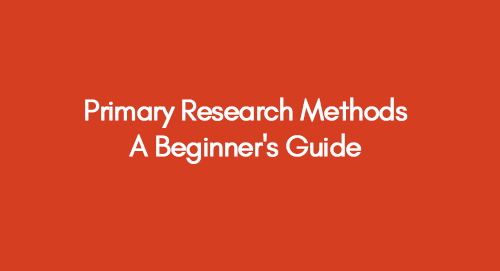
What is ANOVA Calculation & How to Use It
June 6, 2023
What are the Advantages of Primary Research?
June 7, 2023A primary research method for collecting and analyzing data is something that every student and researcher is familiar with. It is a foundation for gathering firsthand data and understanding them is crucial for conducting meaningful and impactful studies. This guide is here to help researchers and students who navigate primary research, its types, and examples for their dissertations.
Explore How to Use Primary Data in Your Dissertation
Discover Different Approaches to Academic Research
Note: Below is a complete guide to ace the skill of primary research for your final project.
Get 3+ Free Custom Topics within 24 hours;
What is Primary Research?
Primary research refers to the collection and analysis of original data directly from the source. It involves firsthand investigation and observation conducted by researchers to address specific research objectives. Unlike secondary research, which relies on existing data, primary research involves gathering new information to gain a deeper understanding of a particular topic or phenomenon.
Types of Primary Research Methods
Below are some of the significant methods of primary research that can help you in conducting your research effectively.
- Surveys: Surveys are a common form of primary research that involves collecting data from a sample of individuals through structured questionnaires.
- Interviews: Interviews provide you with the opportunity to gather in-depth qualitative data by engaging in one-on-one or group conversations. You can be structured, semi-structured, or unstructured, depending on the level of flexibility needed to explore the research topic.
- Observations: Observational research entails systematically watching and recording behaviours, events, or phenomena in their natural settings. It can be participant observation, where researchers actively engage with the subjects, or non-participant observation, where researchers remain uninvolved.
- Experiments: Experimental research involves manipulating variables to determine cause-and-effect relationships. Researchers carefully design experiments to control and manipulate independent variables while measuring the impact on dependent variables.
Primary Research Examples
- Customer Surveys: A company surveys to understand customer satisfaction levels, preferences, and feedback regarding their products or services.
- Focus Groups: A market research firm organises focus groups to gain insights into consumer perceptions, opinions, and preferences related to a new product launch.
- Ethnographic Study: Anthropologist immerses themselves in a specific community to observe and understand cultural practices, rituals, and social dynamics.
- Laboratory Experiment: A scientist investigates the effects of a new drug by conducting controlled experiments on animals or human subjects in a laboratory setting.
Final Thoughts
Primary research serves as a powerful tool for researchers to gather firsthand data and explore specific research questions. Researchers can uncover new insights and contribute to the advancement of knowledge in their respective fields by utilising various methods such as surveys, interviews, observations, and experiments. Embracing primary research enables researchers to delve deeper into their areas of interest and make meaningful contributions to their disciplines.
In this blog post, we have explored the definition of primary research, outlined its types, and provided examples to illustrate its practical application. By leveraging primary research methods, researchers can unlock valuable insights and contribute to the growth and development of their fields of study.
Get an Immediate Response
Discuss your custom requirements with our writers
Free Online Plagiarism Checker For Students
We will email you the report within 24 hours.
Upload your file for free plagiarism
























